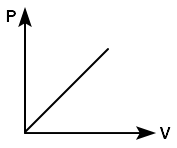In thermodynamic processes, which of the following statements is not true?
| 1. | In an adiabatic process, the system is insulated from the surroundings. |
| 2. | In an isochoric process, the pressure remains constant. |
| 3. | In an isothermal process, the temperature remains constant. |
| 4. | In an adiabatic process, \(P V^\gamma\) = constant. |

To unlock all the explanations of this course, you need to be enrolled.

To unlock all the explanations of this course, you need to be enrolled.
A polyatomic gas \(\left(\gamma = \frac{4}{3}\right)\) is compressed to \(\frac{1}{8}\) of its volume adiabatically. If its initial pressure is \(P_0,\) its new pressure will be:
| 1. | \(8P_0\) | 2. | \(16P_0\) |
| 3. | \(6P_0\) | 4. | \(2P_0\) |

To unlock all the explanations of this course, you need to be enrolled.

To unlock all the explanations of this course, you need to be enrolled.

Match the following:
| Column I | Column II | ||
| \(P\). | Process-I | \(\mathrm{a}\). | Adiabatic |
| \(Q\). | Process-II | \(\mathrm{b}\). | Isobaric |
| \(R\). | Process-III | \(\mathrm{c}\). | Isochoric |
| \(S\). | Process-IV | \(\mathrm{d}\). | Isothermal |
| 1. | \(P \rightarrow \mathrm{a}, Q \rightarrow \mathrm{c}, R \rightarrow \mathrm{d}, S \rightarrow \mathrm{b}\) |
| 2. | \(P \rightarrow \mathrm{c}, Q \rightarrow \mathrm{a}, R \rightarrow \mathrm{d}, S \rightarrow b\) |
| 3. | \(P \rightarrow \mathrm{c}, Q \rightarrow \mathrm{d}, R \rightarrow \mathrm{b}, S \rightarrow \mathrm{a}\) |
| 4. | \(P \rightarrow \mathrm{c}, Q \rightarrow \mathrm{d}, R \rightarrow \mathrm{b}, S \rightarrow \mathrm{a}\) |

To unlock all the explanations of this course, you need to be enrolled.

To unlock all the explanations of this course, you need to be enrolled.

1. \(V_1= V_2\)
2. \(V_1> V_2\)
3. \(V_1< V_2\)
4. \(V_1\ge V_2\)

To unlock all the explanations of this course, you need to be enrolled.

To unlock all the explanations of this course, you need to be enrolled.
Which of the following graph shows the variation of pressure P with volume V for an ideal gas at a constant temperature?
| 1. |  |
2. |  |
| 3. |  |
4. |  |

To unlock all the explanations of this course, you need to be enrolled.

To unlock all the explanations of this course, you need to be enrolled.
Which one of the following processes is reversible?
| 1. | Transfer of heat by radiation |
| 2. | Transfer of heat by conduction |
| 3. | Isothermal compression |
| 4. | Electrical heating of a nichrome wire |

To unlock all the explanations of this course, you need to be enrolled.

To unlock all the explanations of this course, you need to be enrolled.
1. \(450~\text{K}\)
2. \(375~\text{K}\)
3. \(225~\text{K}\)
4. \(405~\text{K}\)

To unlock all the explanations of this course, you need to be enrolled.

To unlock all the explanations of this course, you need to be enrolled.
Can two isothermal curves cut each other?
| 1. | Never |
| 2. | Yes |
| 3. | They will cut when the temperature is 0°C. |
| 4. | Yes, when the pressure is equal to the critical pressure. |

To unlock all the explanations of this course, you need to be enrolled.

To unlock all the explanations of this course, you need to be enrolled.
| 1. | \(64P\) | 2. | \(32P\) |
| 3. | \(\frac{P}{64}\) | 4. | \(16P\) |

To unlock all the explanations of this course, you need to be enrolled.

To unlock all the explanations of this course, you need to be enrolled.
The initial pressure and volume of a gas are \(P\) and \(V\), respectively. First, it is expanded isothermally to volume \(4V\) and then compressed adiabatically to volume \(V\). The final pressure of the gas will be: [Given: \(\gamma = 1.5\)]
| 1. | \(P\) | 2. | \(2P\) |
| 3. | \(4P\) | 4. | \(8P\) |

To unlock all the explanations of this course, you need to be enrolled.

To unlock all the explanations of this course, you need to be enrolled.






